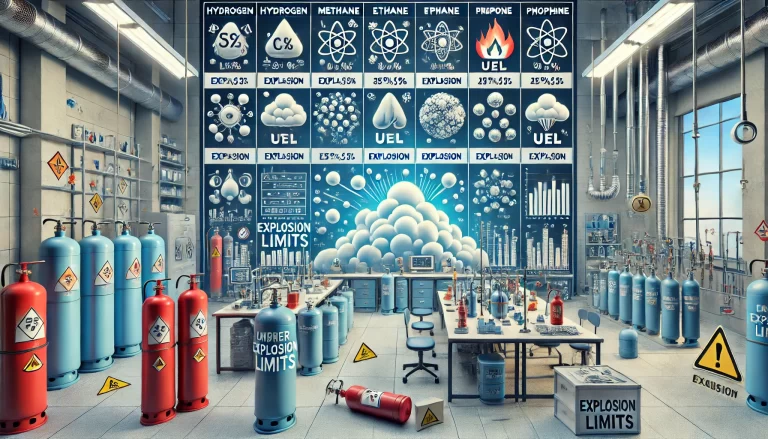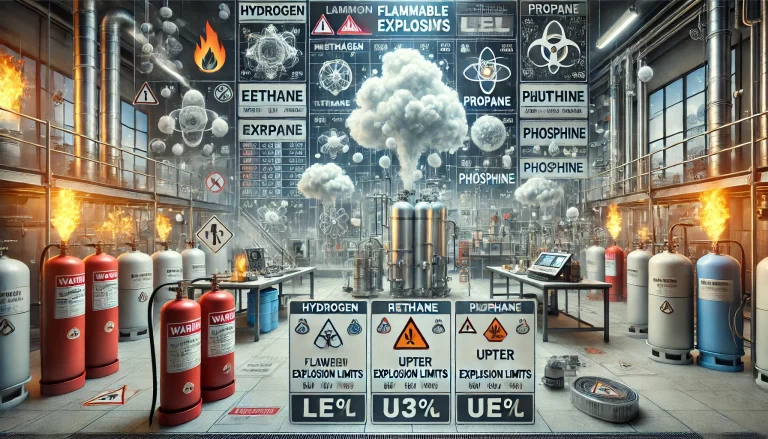Flammable gases can be classified as either single flammable gases or mixed flammable gases, both of which have flammable and explosive properties. The explosion limit refers to the concentration range within which a flammable gas, when mixed with an oxidizing gas, will explode under standard testing conditions. Oxidizing gases can include air, oxygen, or other gases that support combustion.
The explosion limit is the concentration of a flammable gas or vapor in air that can result in an explosion. The lowest concentration that can cause an explosion is called the lower explosion limit (LEL), while the highest concentration is referred to as the upper explosion limit (UEL). The explosion limit varies depending on the composition of the gas mixture.
The most common flammable and explosive gases include hydrogen, methane, ethane, propane, butane, phosphine, and others, each with unique properties and explosion limits.

1. Hydrogen (H₂)
- Properties: Hydrogen is a colorless, odorless, and tasteless gas. It becomes a colorless liquid under high pressure and low temperatures and is slightly soluble in water. Hydrogen is extremely flammable and can explode violently when mixed with air and exposed to fire. In sunlight, a mixture of hydrogen and chlorine can ignite spontaneously. Hydrogen also reacts explosively with fluorine, even in the dark. When stored in cylinders, hydrogen can explode if heated.
- Explosion Limits: 4.0% to 75.6% (by volume)
2. Methane (CH₄)
- Properties: Methane is a colorless, odorless gas with a boiling point of -161.4°C. It is lighter than air and is difficult to dissolve in water. Methane is a simple organic compound that becomes explosive when mixed with air in the right proportions and exposed to a spark. While methane is chemically stable and does not typically react with strong acids, bases, or oxidizers, it can undergo reactions such as oxidation and halogenation under specific conditions.
- Explosion Limits: 5.0% to 15.4% (by volume)

3. Ethane (C₂H₆)
- Properties: Ethane is insoluble in water, slightly soluble in ethanol and acetone, and soluble in benzene. It forms explosive mixtures with air and poses a fire and explosion hazard when exposed to heat or flame. Ethane can also react violently with fluorine and chlorine. It is mainly used in the production of ethylene, vinyl chloride, and refrigerants.
- Explosion Limits: 3.0% to 16.0% (by volume)
4. Propane (C₃H₈)
- Properties: Propane is a colorless, odorless gas that is slightly soluble in water and soluble in ethanol and ether. It is used in organic synthesis.
- Health Hazards: Exposure to propane can cause simple asphyxiation and anesthesia. Short-term exposure to 1% propane usually does not cause symptoms, while concentrations below 10% may only cause mild dizziness. Higher concentrations can lead to unconsciousness and asphyxiation.
- Explosion Limits: 2.1% to 9.5% (by volume)
5. Butane (C₄H₁₀)
- Properties: Butane, also known as normal butane, is one of two isomers with the formula C₄H₁₀. It is a colorless, flammable gas that is easily liquefied. It plays an important role as a raw material in the petrochemical and organic industries.
- Explosion Limits: 1.9% to 8.4% (by volume)
6. Phosphine (PH₃)
- Properties: Phosphine is a colorless gas with a garlic-like odor. It is slightly soluble in cold water and insoluble in hot water. Phosphine is highly toxic and spontaneously combustible.
- Storage and Transportation: Phosphine is rarely transported due to its high reactivity. If necessary, it is stored in compressed gas cylinders. Heat and strong vibration should be avoided.
7. Arsine (AsH₃)
- Properties: Arsine is a colorless gas with a garlic-like odor. It is slightly soluble in hot water and alcohol. When heated, arsine can combust spontaneously, releasing elemental arsenic or forming arsenious acid. It is extremely toxic.
- Storage and Transportation: Arsine is typically produced and used immediately without long-term storage due to its toxicity.

8. Ethylene (C₂H₄)
- Properties: Ethylene is a colorless gas with a sweet, pleasant odor. It is soluble in ethanol, ether, and water and can polymerize easily, particularly in the presence of concentrated sulfuric acid, where it forms resinous substances. Ethylene is flammable and can explode when its concentration in air reaches 3%.
- Explosion Limits: 3.0% to 34.0% (by volume)
9. Acetylene (C₂H₂)
- Properties: Acetylene is a colorless gas with an ether-like odor. It is slightly soluble in water and easily soluble in ethanol and acetone. Acetylene is extremely flammable and explosive, particularly when in contact with phosphides or sulfides.
- Explosion Limits: 2.5% to 80.0% (by volume)
10. Propylene (C₃H₆)
- Properties: Propylene is a colorless gas with a sweet odor. It is soluble in water and acetic acid and highly flammable.
- Explosion Limits: 2.0% to 11.0% (by volume)

Conclusion:
Many industrial environments contain these flammable and explosive gases. To ensure safety, it is advisable to install combustible gas detectors to continuously monitor the concentration of flammable gases and take preventive measures if levels exceed safe limits.
